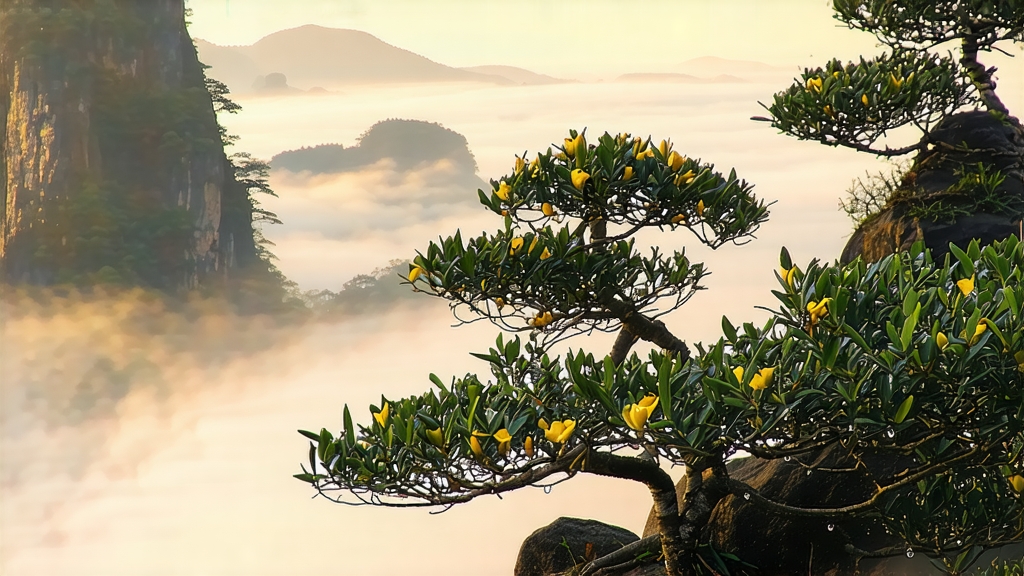
High on Meng Ding Mountain, where Sichuan’s perpetual cloud veil meets the first light of day, a tea once reserved for emperors still unfurls its tiny golden buds each spring. Meng Ding Huang Ya—literally “Yellow Bud from Meng Ding”—is the least-known member of China’s noble yellow-tea family, yet in the Tang dynasty (618-907) it traveled the Jiannan Road to Chang’an as a tribute item whose arrival announced the beginning of the court’s spring tea rites. For more than a millennium the 1,450-meter elevation, constant humidity, and mineral-rich sandstone soils of this summit have shaped a leaf that carries mountain mist in its veins and imperial memory in its aroma.
What makes a tea “yellow” is not leaf color but a slow, finicky micro-fermentation step called men huang—“sealed yellowing.” After kill-green the still-moist leaf is wrapped in thick cloth or stacked in small heaps inside wooden trays; enzymes remain active while moisture and temperature are trapped, nudging chlorophyll toward a muted olive-gold and converting harsh catechins into softer thearubigins. The process is repeated—wrap, rest, unwrap, re-dry—up to three times over 48–72 hours, longer than any other tea craft. One lapse in timing and the leaf slips into green-tea sharpness or, worse, develops sour off-notes. Hence yellow tea is produced only where artisans are willing to gamble a day’s wages on the thermometer’s whim.
Meng Ding Huang Ya is picked once a year, between the Qingming and Grain Rain solar terms, when each bud still hides inside its fish-scale scale leaf and measures no longer than 2.5 cm. A team of two pluckers and one selector work in tandem: the pluckers snap the shoot, the selector discards any leaf whose purple hue signals anthocyanin—an imperial edict from the Song court still observed. By noon the bamboo baskets are rushed downhill to the 1,000-year-old Ganlu Temple courtyard where shallow wicker trays wait under the eaves. Sha-qing—kill-green—is done in a 160 °C wok for exactly 90 seconds, just long enough to silence the oxidative enzymes while preserving a feather-thin rim of moisture around the bud. The leaf is then rolled under a linen cloth into tight, inch-long spindles; the cloth is unwrapped, the leaf aired for five minutes, then re-rolled twice more. What follows is the signature yellowing: 3 kg batches are wrapped in double-layered yellow cotton, stacked inside a bamboo steam box, and left for six hours at 35 °C. The artisans call this “sleeping bud,” and every 30 minutes they lift a corner of the cloth to sniff—aroma must move from fresh bean to warm chestnut without ever touching wet hay. After the third cycle the leaf is dried in three stages: charcoal baskets at 80 °C to arrest enzymes, 60 °C to shape, and finally 40 °C to coax the remaining 5 % moisture out of the bud’s core. The finished tea looks like slender golden needles, downy at the tip, smelling of sweet corn and distant orchid.
To brew Meng Ding Huang Ya Western-style, use 3 g for 250 ml of water at 85 °C and infuse three minutes; the liquor glows like late-afternoon Chablis. For gongfu, a 120 ml gaiwan receives 5 g; the first three steeps last 25, 35, and 45 seconds at 80 °C, then add ten seconds for each subsequent infusion. A silver-rimmed glass cup is traditional on Meng Ding: it lets drinkers watch the buds stand upright—“the golden bamboo shoot in spring soil”—before sinking in graceful unison. Whatever the method, always pre-warm the vessel; yellow tea’s softened tannins punish lukeware with dullness.
Tasting begins with the dry leaf: rub three buds between thumb and forefinger—if they squeak faintly, residual moisture is ideal. Inhale: you should find fresh lychee and a trace of toasted sesame. After the first infusion lift the lid of the gaiwan; hot vapor carries the scent of mountain stone after rain. Sip, letting the liquor rest on the tip of the tongue—acidity arrives first, like Meyer lemon, then folds into creamed corn sweetness. The middle palate reveals a snap-pea greenness that